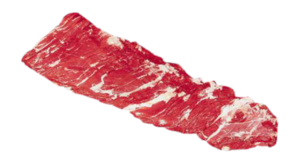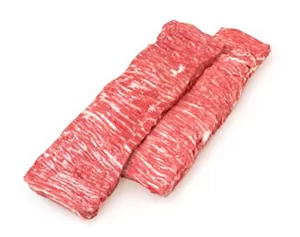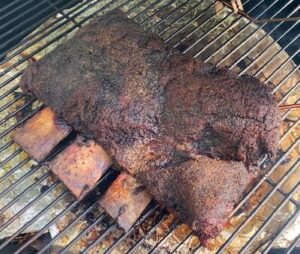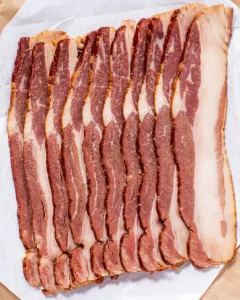A Guide to the Cuts of Beef Part Three
- Richard Reynolds Jr.

The Purpose of the Post:
In my last blog post, ‘A Guide to the Cuts of Beef Part Two,’ I delved into the chuck portion of the cow (steer). I discussed the importance of different cooking methods based on the location of cuts within the chuck. Additionally, I outlined the various cuts that comprise the chuck portion, emphasizing its position in the front quarter of the cow. I also provided insight into the tools used by butchers or meat processors to extract these cuts and gave brief descriptions of each cut. If you’d like to read ‘A Guide to the Cuts of Beef Part Two,’ you can find it here https://fireinthekettle.com/a-guide-to-the-cuts-of-beef-part-two/ In this blog post, I’ll be shifting gears momentarily to shift the focus back to the plate.
The Plate Section:
In my previous blog post, ‘A Guide to the Cuts of Beef Part One,’ I discussed how the butcher or meat processor divides the carcass of the cow (steer) between the fifth and sixth ribs, resulting in the separation of the front quarter and hind quarter. The front quarter contains the chuck portion, which I elaborated on in detail. If you’d like to revisit ‘A Guide to the Cuts of Beef Part One,’ you can find it here https://fireinthekettle.com/a-guide-to-the-cuts-of-beef-part-one/. Continuing from there, I detailed the process of removing the skirt steak from the top of the plate section, employing a sharp six-to-eight-inch semi-stiff boning knife. However, what I didn’t cover is that there are actually two skirt steaks removed from the plate section. The first one, known as the outer skirt steak, is taken from the top of the plate. The second one, called the inner skirt steak, is situated inside the abdominal cavity, attached to the underside of the ribs and the diaphragm muscle near the sternum. The inner skirt steak is carefully separated from the surrounding connective tissues, including the diaphragm and any excess fat, using a sharp knife. Once separated, any excess fat, connective tissue, or silver skin is trimmed away to enhance its appearance and tenderness.
The Outer Skirt Steak vs the Inner Skirt Steak:
Typically, the inner skirt steak is considered more tender than the outer skirt steak. This is because the inner skirt, also known as the “inside skirt,” is located closer to the diaphragm muscle and has less connective tissue compared to the outer skirt, which is located nearer to the flank. However, both cuts can be delicious when cooked properly, and the tenderness can also depend on factors such as aging, marinating, and cooking technique. It is important to note that the outer skirt steak is indeed longer and wider in terms of dimensions, the inner skirt steak is typically larger in terms of weight. Therefore, while the outer skirt may appear larger visually, the inner skirt often yields larger portions of meat when trimmed and prepared for cooking.


The 1 2 3 A Cut Beef Ribs:
The 1 2 3 A Cut Beef Ribs may be an unfamiliar cut of beef to some. Traditionally, these ribs are cut into short ribs, which are notable for their substantial size. However, if left intact, the 1 2 3 A Cut Beef Ribs are referred to as ‘beef plate ribs’ or colloquially known as ‘dinosaur ribs.’ These ribs originate from the plate primal cut of the cow, located below the rib primal cut. The name ‘1 2 3’ comes from the three large bones typically present in this cut (numbered as 1, 2, and 3), along with a portion of rib meat. The ‘A’ designation may indicate the grade of beef or be part of the naming convention. Known for their rich flavor and tenderness, these beef plate ribs are often favored for low and slow cooking methods, such as on a barbecue or smoker.


Beef Bacon:
After the Outer and Inner Skirt Steaks have been removed from the plate section, the available cuts of beef from this area are exhausted. However, the remaining portion of the plate can be utilized by the butcher or meat processor to produce beef bacon. To begin this process, the butcher or processor will trim away the plate ribs from the plate. It’s worth noting that in the case of pork, these ribs would be known as ‘St. Louis Style’ ribs. In some regions, these plate ribs are alternatively referred to as Beef Belly. Once separated from the plate, this section is set aside. The butcher or processor then prepares the remaining portion of the plate by squaring it up. This involves removing the Navel, trimming excess fat from both ends, and finally, shaping the remaining portion into beef bacon slices.


Rose Meat:
The first thing the butcher or meat processor will do is remove the rose meat from off of the flank. Rose meat may be another cut of beef that is unfamiliar to you. The reason this cut is referred to as Rose Meat is due to its lighter red color. It is important to note that Rose Meat is high in fat content. This cut of beef if cooked properly will melt in your mouth. Normally the butcher or meat processor will reserve the Rose Meat for ground beef. However, Rose Meat boiled, fried, grilled or oven cooked. It can be served as a main course or even an appetizer. In Mexican cuisine rose meat is known as “suadero” and is a favorite in tacos. At times some can confuse the beef Rose Meat cut with that of the hanger steak or brisket, but the Rose Meat is a distinct cut of beef that has its own unique qualities. A point of interest no matter how the Roast Meat is cooked or used, the Rose Meat should be marinated prior to cooking, perhaps overnight in the refrigerator. It is important to note that Rose Meat absorbs flavors very well.

Flank Steak:
After removing the rose meat, the butcher or meat processor will isolate the section containing the flank steak. This area often contains substantial amounts of fat and gristle. Using a sharp semi-stiff boning knife, the butcher or processor will meticulously trim away the excess fat and gristle to facilitate the removal of the flank steak. Once the fat and gristle are removed, they will also detach the membrane to expose the flank steak. The butcher or meat processor will follow a seam known as the ‘flank seam’ or ‘flank separation.’ This seam is a natural division between muscles in the beef carcass, separating the flank steak from surrounding connective tissue, fat, and other muscles. Following the flank seam is crucial for obtaining a clean cut of flank steak, as it helps ensure minimal waste and maximizes the yield of usable meat. Additionally, it aids in maintaining the integrity of the flank steak’s shape and texture, contributing to its tenderness and overall quality. The final steps in trimming the Flank Steak is the butcher or meat processor will remove the fat line located atop of the Flank Steak towards the bottom of the Flank Steak. Once the fat line is removed the butcher or meat process will round the Flank Steak where the fat line was located, and the beef Flank Steak is completed.
In Closing:
In this blog post, I delved into the cuts of beef originating from the Front Quarter of the cow (steer), focusing on notable selections such as the Outer and Inner Skirt Steak. We explored how these cuts are removed and compared their qualities. Additionally, I introduced lesser-known cuts like Beef Bacon and the 1 2 3 A cut beef ribs. Transitioning to the Hind Quarter, I discussed the Rose Meat and the Flank Steak. This journey into the Hind Quarter will continue in my next blog post, where we’ll uncover more intriguing cuts. Your feedback is invaluable, so please don’t hesitate to share your thoughts by clicking the ‘Click Here to Send Us Your Comments on This Post’ link below. Thank you for reading!
